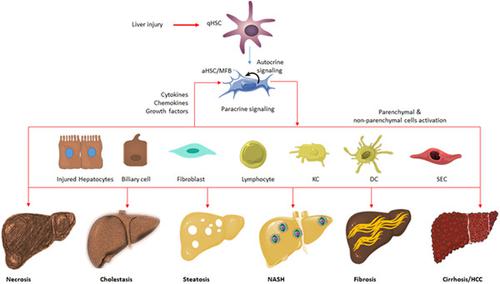当前位置:
X-MOL 学术
›
J. Cell. Physiol.
›
论文详情
Our official English website, www.x-mol.net, welcomes your feedback! (Note: you will need to create a separate account there.)
Hepatic stellate cells in the injured liver: Perspectives beyond hepatic fibrosis
Journal of Cellular Physiology ( IF 5.6 ) Pub Date : 2021-09-12 , DOI: 10.1002/jcp.30582 Devaraj Ezhilarasan 1
Journal of Cellular Physiology ( IF 5.6 ) Pub Date : 2021-09-12 , DOI: 10.1002/jcp.30582 Devaraj Ezhilarasan 1
Affiliation

|
Over the last two decades, our understanding of the pathological role of hepatic stellate cells (HSCs) in fibrotic liver disease has increased dramatically. As HSCs are identified as the principal collagen-producing cells in the injured liver, several experimental and clinical studies have targeted HSCs to treat liver fibrosis. However, HSCs also play a critical role in developing nonfibrotic liver diseases such as cholestasis, portal hypertension, and hepatocellular carcinoma (HCC). Therefore, this review exclusively focuses on the role of activated HSCs beyond hepatic fibrosis. In cholestasis conditions, elevated bile salts and bile acids activate HSCs to secrete collagen and other extracellular matrix products, which cause biliary fibrosis and cholangitis. In the chronically injured liver, autocrine and paracrine signaling from liver sinusoidal endothelial cells activates HSCs to induce portal hypertension via endothelin-1 release. In the tumor microenvironment (TME), activated HSCs are the major source of cancer-associated fibroblasts (CAF). The crosstalk between activated HSC/CAF and tumor cells is associated with tumor cell proliferation, migration, metastasis, and chemoresistance. In TME, activated HSCs convert macrophages to tumor-associated macrophages and induce the differentiation of dendritic cells (DCs) and monocytes to regulatory DCs and myeloid-derived suppressor cells, respectively. This differentiation, in turn, increases T cells proliferation and induces their apoptosis leading to reduced immune surveillance in TME. Thus, HSCs activation in chronically injured liver is a critical process involved in the progression of cholestasis, portal hypertension, and liver cancer.
中文翻译:

受损肝脏中的肝星状细胞:肝纤维化之外的观点
在过去的二十年里,我们对肝星状细胞 (HSCs) 在纤维化肝病中的病理作用的理解急剧增加。由于 HSC 被确定为受损肝脏中主要的胶原蛋白生成细胞,因此一些实验和临床研究已针对 HSC 治疗肝纤维化。然而,HSCs 在发生非纤维化肝病如胆汁淤积、门静脉高压症和肝细胞癌 (HCC) 中也发挥着关键作用。因此,本综述仅关注活化的 HSC 在肝纤维化之外的作用。在胆汁淤积的情况下,胆汁盐和胆汁酸升高会激活 HSC 分泌胶原蛋白和其他细胞外基质产物,从而导致胆汁纤维化和胆管炎。在慢性损伤的肝脏中,来自肝窦内皮细胞的自分泌和旁分泌信号激活 HSC,通过释放 endothelin-1 诱导门静脉高压。在肿瘤微环境 (TME) 中,活化的 HSC 是癌症相关成纤维细胞 (CAF) 的主要来源。活化的 HSC/CAF 与肿瘤细胞之间的串扰与肿瘤细胞增殖、迁移、转移和化学抗性有关。在 TME 中,活化的 HSC 将巨噬细胞转化为肿瘤相关巨噬细胞,并分别诱导树突状细胞 (DC) 和单核细胞分化为调节性 DC 和髓源性抑制细胞。这种分化反过来又增加了 T 细胞的增殖并诱导其凋亡,从而导致 TME 中的免疫监视减少。因此,
更新日期:2021-09-12
中文翻译:

受损肝脏中的肝星状细胞:肝纤维化之外的观点
在过去的二十年里,我们对肝星状细胞 (HSCs) 在纤维化肝病中的病理作用的理解急剧增加。由于 HSC 被确定为受损肝脏中主要的胶原蛋白生成细胞,因此一些实验和临床研究已针对 HSC 治疗肝纤维化。然而,HSCs 在发生非纤维化肝病如胆汁淤积、门静脉高压症和肝细胞癌 (HCC) 中也发挥着关键作用。因此,本综述仅关注活化的 HSC 在肝纤维化之外的作用。在胆汁淤积的情况下,胆汁盐和胆汁酸升高会激活 HSC 分泌胶原蛋白和其他细胞外基质产物,从而导致胆汁纤维化和胆管炎。在慢性损伤的肝脏中,来自肝窦内皮细胞的自分泌和旁分泌信号激活 HSC,通过释放 endothelin-1 诱导门静脉高压。在肿瘤微环境 (TME) 中,活化的 HSC 是癌症相关成纤维细胞 (CAF) 的主要来源。活化的 HSC/CAF 与肿瘤细胞之间的串扰与肿瘤细胞增殖、迁移、转移和化学抗性有关。在 TME 中,活化的 HSC 将巨噬细胞转化为肿瘤相关巨噬细胞,并分别诱导树突状细胞 (DC) 和单核细胞分化为调节性 DC 和髓源性抑制细胞。这种分化反过来又增加了 T 细胞的增殖并诱导其凋亡,从而导致 TME 中的免疫监视减少。因此,



























 京公网安备 11010802027423号
京公网安备 11010802027423号